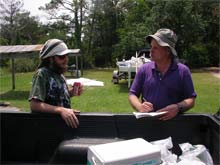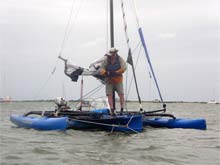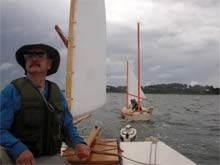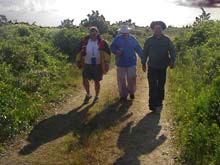| To Part
Two
To Part Three
Where Blackbeard Played
The OBX130 is an informal, unsupported, sailing and camping event
that takes place in the scenic Outer Banks off North Carolina.
More information can be found at https://obx130.com
We arrived at the campground on Cedar Island mid-morning on Sunday
after dragging our boat, Laguna
Dos: Blue Laguna, 1300 miles across the heartland of America,
from her home in Oklahoma to the windswept shores of the Outer
Banks of North Carolina. The drive had been grueling, but it had
been a different kind of gruel than that which was to follow over
the next five days.
 |
The author with the pirate-y Stewart Bartlett |
At the beach was a motley collection of small boat enthusiasts:
The entire male side of the Moffitt clan: Bill, Paul (organizer
of the OBX130), and Sean. Bill had brought his Michalak-designed
Mikesboat, Ember's Watch, as well as his
good friend, Chuck “the Duck” Leinweber, owner/operator
of Duckworks Boating Supplies. Sean had brought his Michalak-designed
Piccup Squared, Patox, while pirate-y looking
Paul came with just a friend, Stuart Bartlett, who looked even
more pirate-y with three-foot dreadlocks, a scruffy beard, and
authentic pirate accent from his native home of Essex, England.
Luckily for us, Paul and Stuart, having driven down from Philadelphia,
PA, were to be 'free-boaters' rather than freebooters as they
were going to hitch rides on any available craft.
All the way from Holland, Michigan, and already in the water,
was David Chase, with his boat Northern Gannet, the only other
Mikesboat known to exist. David had his boat professionally
built and she brought joy to the eyes of all who beheld her.
| David Chase at the helm of "Northern Gannet" |
 |
Tony Day had the shortest commute, coming from Winterville,
NC, with his Princess 22, Susan G, a cat-ketch designed by B&B
Yacht Designs. As we guided her off the trailer and into the water,
the affable Mr. Day patted her stem and lovingly declared in his
strong southern accent, “This boat represents three years
of my life.”
 |
Tony Day relaxes aboard his Princess 22 "Susan G" |
“Mac” McDevitt brought his blue, roto-molded Windrider
17 from Essex, NY and was eager to see how she performed against
the yellow Windrider 17 Bob Grona had trailered up from Huntsville,
TX. The participant list of the '10 OBX130 was rounded out with
David Ware from Rockport, TX, with Merlin, his modified Bolger
peapod, that, in addition to being stretched 1.5x or 2x, has a
unique hard bimini for sun protection.
| “Mac” McDevitt aboard his Windrider. |
 |
The OBX130 was also providing a bit of a messabout for several
members of the Philadelphia chapter of Traditional Small Craft
Association (TSCA.) Mike Wick and John Guidera had a Melonseed
dinghy, Doug Oeller and Kevin MacDonald had the Comfort, a beautifully
built Marshcat, and Phil Maynard brought his Curlew 17 that was
powered with the motor from a Subaru lawnmower. The men from the
TSCA planned to stay in camp at Cedar Island and go on daysailing
excursions.
 |
The TSCA crew setting up camp. |
While we waited for evening, Mike Monies and I splashed Blue
Laguna and did a test run, sailing out the narrow channel with
the 10-12 mph wind directly in our teeth. After the Laguna's maiden
voyage in the Everglades Challenge in March, 2010, Mike had made
some adjustments to the rigging and we wanted to test them out.
She performed wonderfully, pointing very well and came through
the stays without a hitch. By backing the forward sail while powering
with the aft sail, we could bring her through the eye of the wind
in less than a boat length. We easily beat to windward and zipped
out the narrow channel, spun her about, and ran her wing-and-wing
back to the dock.
The wind was blowing and rain was spitting – the first
tropical depression of the year was threatening to form just off
shore – so after the Captain's Meeting, we adjourned to
an excellent meal of barbecued ribs (buccaneer style) at the Driftwood
Inn and retired to our camps. After dark, the last member of our
expedition pulled in, Pete Lamarche from Kingsville, Ontario.
This plucky Canadian had a very well appointed production boat
rarely seen in the US, a Nordica 16 named Jester. Pete had run
into a bit of bad luck as he had no charts. He had been expecting
to navigate with his brand new, US purchased GPS, but the GPS
had to be initialized while connected the internet, and there
was no internet capability at Cedar Island. Bill, the senior Moffett,
proffered a slightly-less-than-adequate-but-better-than-nothing
sport fisherman map produced by the North Carolina tourism board,
which Pete gladly accepted.
| Pete Lamarche from Kingsville, Ontario. |
 |
That night, the skies opened up at 12:59 am, and I had the first
inkling that my supposedly 'waterproof' bivysack sleeping system
might not have been an appropriate choice for a week-long sailing
excursion in the springtime on the Carolina coast.
Monday dawned with gray skies, clouds, and lots of wind. Mike
and I left the beach first, after rowing away from the docks,
grounding in some reeds, and hoisting our dual balanced lugsails
without endangering the other boats in our flotilla. The wind
was a perfect 10-12 mph from slightly north of east and we were
able to sail out the channel and weather the headlands without
a tack. I had 'gone cheap' on the charts for this trip and printed
out NOAA Booklet charts for the region -11550 for the area around
Cedar Island and north, 11545 for the Core Sound south to Cape
Lookout Bight. Being the clever lad I am, I had sealed them against
the weather in plastic sheet protectors from Office Depot. Within
minutes the light rain had found access through the sheet protectors
and soaked the charts. While this might have been a disaster,
I had two bits of luck in my favor: First, I had used a laser
printer to print the charts and toner is not hydrophilic like
inkjet ink – so the printing didn't run and the pages were
still legible. Second, the Laguna has a wonderfully shallow draft,
about five inches the way we had her loaded, so the need for charts
in the notoriously skinny, but rock-less, waters of the Outer
Banks was reduced – not eliminated, just reduced.
Our goal for the day was an abandoned Core Sound Rod and Gun
Club (N34° 48.263 W76° 22.538) about midway between the
launch at Cedar Island and Cape Lookout Bight to the south, about
13 crow-flying miles from Cedar Island, but more like 19 by boat.
The wind was beginning to stiffen so we decided to run almost
all the way across the Core Sound to seek protection in the lee
of the barrier islands. The shallow waters quickly build a steep
chop that makes sailing a tad unpleasant as the Laguna's flat
bottom slaps across the wavetops. The rest of the fleet sailed
in the deeper waters closer to the lee shore, over by the mainland.
This required them to tack several times to gain sea room, and
Patox, Sean's little piccup pram, was taking heavy spray as her
blunt snout smashed through the chop. In a short time and with
great regret, Sean prudently decided to live to sail another day
and returned to the docks, followed by Ember's Watch with his
father at the helm and Chuck acting as ballast. Sean left the
mighty Patox in the care of the TSCA group and shifted his dunnage
to the much larger Mikesboat, demoted from Captain to 1st Mate.
The other Moffett, Paul, had joined David Chase on his Mikesboat, Northern Gannett, while Stuart was sailing in absolute luxury
on Tony Day's Princess 22, Susan G - the 'Queen Mary' of our fleet,
the two sails of her ketch rig flying proud over her cream colored
hull. Both Windriders were being single-handed, as was Jester,
the Nordica 16 from Canada, and David Ware's double-ender, Merlin.
 |
Sean returns to the docks - Bill Moffitt at the helm of "Ember's Watch". |
The passage to the gun club took a heavy toll. On Blue Laguna,
our first scare came when the rudder grounded and popped out of
its gudgeons. We were ripping along at over 8 mph when Mike noticed
he didn't have any steerage, looked back, and sounded the alarm.
I scrambled over the aft storage compartment and snagged the steering
lines that kept the dangling rudder attached to our stern (Mike
has the Laguna set up with centralized steering, running lines
from the tiller around the aft cockpit to the deckbeam amidships.)
As I struggled to pull the slipping, sliding, slithering, rudder
assembly back into the boat, Mike steered by alternately backing
the forward sail allowing it to fall off. It was a masterful bit
of seamanship that proved to us the symmetrical sail rig of the
Laguna was the true balancing force and the rudder was there to
provide fine-tuning. After a few frustrating attempts, the pintles
finally lined up with the gudgeons and I was able to re-ship the
rudder. Mike had me tie a bit of small line over the tiller and
under the gudgeon to keep the rudder in its place in the future.
The rudder had popped when we had grounded (I’d lashed
down the kick-up rudder’s downhaul) but that was not the
only time we grounded on that first day's passage. As shallow
drafted as the Laguna is, the waters of the Core Sound are even
shallower. We skipped over the sands on the north side of Dump
Pass (N34° 30.949’, W76° 19.315) moving at 10 mph
in waters as skinny as eight inches is just as thrilling as it
sounds – but just as were really beginning to scream, we
came to a screeching halt. Mike had the sails set perfectly for
the conditions and we could feel Blue Laguna struggling to pop
up on plane. We could hold speeds of just over 10 mph for 30 seconds
or more, then it'd feel like she'd just pop up and slide, and
we'd touch 12 mph before she'd suck back down again. The wake
looked like it was coming from a powerboat and I could see the
ripples in the sand as our boat sped south. One more pop-up, one
more touch of 12.2 mph, and we slid to a soft stop. As soon as
she struck, we cast loose the sheets to prevent her from going
broadside and rolling. I hopped out to push, lightening the load,
while Mike worked the sails for power and we skip/bumped along
for several yards, then Mike hopped overboard as well. As the
water was only ankle deep and the bottom was soft sand, working
the boat free was no major chore. We ended up pushing her along
for 400 yards or so before we cleared the shallows and started
ripping south again.
By this time, the fleet was scattered and out of sight. With
just a coordinate for our GPS and a set of soggy, low-resolution
charts, we made our way towards the gun club. The straight-line
bearing from the GPS had us going over waters charted at six inches.
We were reluctant to run aground again, so we dropped off the
wind a bit, aiming for waters listed to be a generous 12 inches
or so. Even as the winds were easing, we still made good time
and soon identified the cupola of the abandoned gun club on the
horizon. We again ran afoul of the shallows just before the docks
as we threaded through some marshy patches. Tony Day in his Susan
G (the Princess 22) hailed us, saying he and Stuart were about
an hour out, just entering the shoals in front of the gun club
– then they grounded. We were well practiced at grounding
by now, so through fits and starts, we made it to the dock well
before any of the other boats, so we sat on the dock and watched
the fun.
| Mike and the author on the docks at the Gun Club. |
 |
Susan G arrived in due time, followed by both Mikesboats,
and quite a bit later, McDevitt in his Waverider 17. We learned
that David Wade had assessed the conditions and elected to stay
on shore, and that Bob Grona had decided to keep his Waverider
17 on shore as well. It must be said that the TSCA guys had set
up a very nice, very dry, camp back at Cedar Island, complete
with a screened in tent for sitting and listening to Doug Oeller
sing and play sea chanteys on his guitar. A smart man would have
had an easy choice between day-sailing and eating in restaurant
or striking out downwind for a multi-day expedition in dodgy weather
and fitful seas.
The final arrival was Pete Lemarche in Jester, his Nordica 16
– the 1’ 10” draw of his full keel had played
havoc in the skinny waters of Core Sound. Upon arrival, he anchored
out a bit, hopped overboard with a cooler, informed us all that
May 24th is the Queen's Birthday, and gave us all a beer. It was
then we learned that besides not having a 'real' chart or working
GPS, he also didn't have a VHF radio, as VHF operators are required
to be licensed in Canada. Say what you will about how a man prepares
for an excursion, with his cheery attitude, sturdy boat, and free
beer, I liked the cut of his jib.
 |
The ruins of the Core Sound Rod and Gun Club. |
Our campsite was a flat patch of deerfly-infested ground that
housed the ruins of the Core Sound Rod and Gun Club. While I slathered
on sunscreen and bug spray, I struck up a conversation with the
grizzled foreman of a survey crew that was driving a reference
stake into the front lawn of the club. This man had attended parties
at the gun club in his youth and told me a bit of its history
as he monitored the other two members of his crew from the comfort
of a folding chair. I learned the US government converted the
Outer Banks into a National Seashore in the early 1970's, condemning
all the buildings and residences thereon. At first, the foreman
had been angry about the condemnation, then finally admitted it
had probably been a good thing. [to be read in a deep, gravelly
voice with a thick, southern accent] “Sure'n the club took
care 'o thea prop'ty, but mosta the folks were just trashin' these
islands. The gub 'ment musta hauled ova 4,000 rustin' cars offa
hea. Cain't even begin ta' count the tons o' garbage. People done
got theyselves kicked offa these islands.”
Between episodes of running the gauntlet of deerflies to get
over and explore the Atlantic side of the island – where
the surf was REALLY pounding, and sitting on the deteriorating
docks, watching black skimmers fish and white Ibis fly, we cleaned
our boats and gear and picked up trash around our campsite. Paul
was adamant that we left the campsite in better shape than we
found it.
| Pete, Bill and the author run the deerfly gauntlet. |
 |
Nightfall came as nightfall does and we retired to our various
sleeping accommodations. The flies and mosquitoes were so voracious,
none dare sleep in the lee of the gun club or near the bushes.
While the Moffetts and several others pitched tents on the flat
lawn, Mike and I opted to sleep in the roomy Laguna. Michalak
had designed the Laguna for excursions and Mike had built her
with camping in mind, each cockpit is large enough for four adults
to sit in while sailing and the floorboards can be raised up to
the level of the seat tops, making a sleeping space large enough
to accommodate four adults sleeping in comfort. Mike set his cot
and tent up in the forward cockpit while I stretched out in my
bivysack in the aft. While the night was dry, the wind continued
to blow, noisily driving waves against the sides and under the
rocker where they slapped and popped all night.
 |
Sunset at the gun club. |
To be conintued tomorrow...
*****
More articles about the OBX130:
I
can’t believe I ate half that bag of … !
By Sean Moffitt
The
OBX By Paul Moffitt
Article
in Reports by Paul
The OBX 130 Website

*****
|

